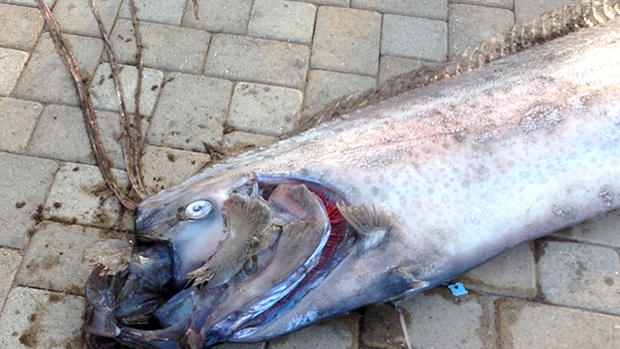California's giant "sea serpent" oarfish had parasites
One of two oarfish found in Southern California waters earlier this month had a host of parasites living in its giant, serpent-like body.
Scientists from the University of California, Santa Barbara last week dissected the 18-foot oarfish found off Catalina Island and found large, larval tapeworms in its intestine. An adult spiny-headed worm also was found embedded in the intestine.
Scientists say the discovery of the parasites is important because it tells them what the natural enemies of the oarfish are and could indicate where the elusive fish lives or hunts for food.
A snorkeler found the carcass of the oarfish Oct. 13.
Several days later, another oarfish measuring about 14 feet long washed ashore in Oceanside, in San Diego County. When that fish was dissected last week, it was found to be a female ready to spawn. Marine biologists say it was carrying hundreds of thousands of eggs that were nearly ready to be released.
Scientists say the smaller of the two oarfish appeared to be in good health before it died.
Necropsies -- the animal version of an autopsy -- were performed on both fish, but scientists were unable to determine the cause of death. They preserved some of the tissue and organs and plan to send samples to researchers around the world to examine.
Oarfish are thought to be poor swimmers and it's possible that these two got caught in a current that pushed them to coastal waters, marine experts said.
"If they get disoriented and into the surf zone, they'll probably have trouble maneuvering back out to sea," said Phil Hastings, curator of the marine vertebrate collection at the Scripps Institution of Oceanography.
Oarfish are found in tropical waters, generally from around 500 to 1,000 feet deep, although some may reach more than 3,000 feet deep. That makes it difficult for scientists to study them.
The rarely-seen creatures can grow to more than 50 feet long. Oarfish may be the inspiration for sea monsters found in literature and throughout history.
Photos of the oarfish have circulated widely online, spurring interest in the mysterious sea creatures.
However, these two incidents contribute little to scientists' knowledge of the species, explains marine biologist Milton Love of the University of California, Santa Barbara. "You wouldn't know much about deer based on roadkill," he said.
